Adolescent Program
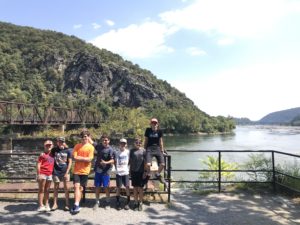 Adolescence is a time of life that involves more change – physical, emotional, and cognitive – than any other besides infancy. In addition to being a period of rapid growth, it is a time of great developmental variation. Like all students in what Maria Montessori termed “the Adolescent plane of development,” Mountainside’s 12 to 15 year olds are transitioning to the adult realm. Some students arrive in the Adolescent Program full-fledged teenagers, while others take more time entering the first stages of puberty. Their bodies and minds are undergoing powerful changes and they are beginning to sort out and tackle grown-up roles, relationships, and responsibilities. Though often unsure and untested, they are thirsty for intellectual stimulation, creative expression, independence, and internal validation.
Adolescence is a time of life that involves more change – physical, emotional, and cognitive – than any other besides infancy. In addition to being a period of rapid growth, it is a time of great developmental variation. Like all students in what Maria Montessori termed “the Adolescent plane of development,” Mountainside’s 12 to 15 year olds are transitioning to the adult realm. Some students arrive in the Adolescent Program full-fledged teenagers, while others take more time entering the first stages of puberty. Their bodies and minds are undergoing powerful changes and they are beginning to sort out and tackle grown-up roles, relationships, and responsibilities. Though often unsure and untested, they are thirsty for intellectual stimulation, creative expression, independence, and internal validation.
In order to nurture and support this sensitive period, we have designed our program around the needs, sensitivities, and strengths of adolescents. In doing so, we have given careful attention to balancing an early adolescent’s need for activity and movement with the importance of developing attentiveness and concentration. Integrated into the academic areas or treated as separate entities, the following are emphasized in our program:
- The importance of growth as a moral human being
- A sense of membership in, and responsibility to, our community and the greater world
- A responsibility for one’s own education and behavior
- The importance of healthy physical, emotional and social growth
Our Program’s Goals:
- To create a safe, nurturing atmosphere that values respect and involvement
- To create a challenging academic program at all levels and competencies
- To inspire a love of learning
- To help students acquire the tools necessary to learn independently
- To instill in our students the belief that each and every one of them has something important to contribute to the world
THE MICROECONOMY
As our Adolescents seek to find their place in society, being connected with the economy creates real, meaningful work and life lessons while raising money to support their own educational program. The Adolescents run their own businesses and track all their finances in QuickBooks.
The Adolescent students run a hot lunch program for the larger school, design and sell Mountainside apparel, create natural wreaths, sell Holiday Bakery Baskets, prepare and serve Community Breakfasts, and partner with a local restaurant to prepare a pork-based meal as a fundraiser with one of the hogs they raise.
THE FARM
The Mountainside Farm is an important component of the Adolescent program and their micro-economy. As Adolescents seek to find their place in society and meaning in their work, the farm provides an overarching business model that illustrates the practical application of their lessons. Large, real, meaningful, physical work is also crucial at this stage of development. The farm provides a place for Adolescents to be fully engaged in the process of running a business, and allows aspects of their academic focus to take on new meaning and connection. The farm creates an ideal place for young Adolescents to realize their capabilities, develop their sense of self, engage in physical work, problem solve, work collaboratively, and contribute valuable work to their community while raising money to support their own educational program. Mountainside’s Adolescents currently raise hogs, turkeys, and chickens on the farm.
THE ADOLESCENT ACADEMIC CURRICULUM INCLUDES:
Math
As students tran sition out of the Elementary grades, they have a growing capacity for abstract thinking and analysis. Thus, the Adolescent Program’s Algebra and Geometry curricula combine more traditional instruction – including text books, direct lessons, and lab work – with Montessori approaches that include manipulative materials and projects. The curricula also follow an authentic Montessori approach in which math is not taught simply as an isolated discipline, but rather in the context of human history and culture. Classroom learning is integrated with the use of mathematics as part of the occupations, science, and other disciplines. Students use math to help maintain the accounts for their student-run businesses and learn to track and assess finances through the use of a QuickBooks accounting system.
sition out of the Elementary grades, they have a growing capacity for abstract thinking and analysis. Thus, the Adolescent Program’s Algebra and Geometry curricula combine more traditional instruction – including text books, direct lessons, and lab work – with Montessori approaches that include manipulative materials and projects. The curricula also follow an authentic Montessori approach in which math is not taught simply as an isolated discipline, but rather in the context of human history and culture. Classroom learning is integrated with the use of mathematics as part of the occupations, science, and other disciplines. Students use math to help maintain the accounts for their student-run businesses and learn to track and assess finances through the use of a QuickBooks accounting system.
Communication Skills
Language and composition 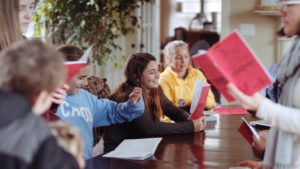 both permeate the Adolescent Program as students read, write, spell, present, analyze, memorize, create, teach, and explore the history of words. Because development of written and oral skills requires constant use and practice, students are given boundless opportunities to use language in its many forms, and to celebrate its beauty, power and mystery.
both permeate the Adolescent Program as students read, write, spell, present, analyze, memorize, create, teach, and explore the history of words. Because development of written and oral skills requires constant use and practice, students are given boundless opportunities to use language in its many forms, and to celebrate its beauty, power and mystery.
Adolescent students read age-appropriate literature. Through seminars and discussion, students learn to analyze plot, literary structure, themes, character, writing styles, and figurative language. In addition to reading a variety of diverse novels, students delve into non-fiction, poetry, biographies, philosophy, newspapers, journals, scripts, and the work of peers. Topics of novels often address the social curriculum for the Adolescents, tackling topics of moral and ethical value while considering diverse perspectives and complexity of issues.
Written and oral skills are honed in a variety of ways. Students may direct their creativity to writing fiction, poetry, scripts or lyrics. Expository writing takes many forms, including composition of reports and essays, presentations, summaries, outlines and even business letters. Presentations are routinely woven into projects and work in the Adolescent Program.
Science
Life Science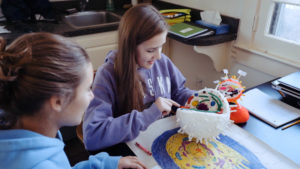 , Environmental Science, and Physical and Earth Science are taught in a three-year rotation. The science curriculum centers around the scientific method while using the local area and Mountainside farm to apply meaningful study and evidence. The curriculum provides a rigorous, integrated, and hands-on foundation in botany, biology, geology, zoology, chemistry, and physics. The basis of students’ scientific exploration is the natural environment of the farm itself: the earth, soil, water, plant and animal life, and the work students perform there on a daily basis. Students study and apply science using their surroundings as a natural laboratory. They enhance findings with course work, research through printed resources and internet sources, traditional experimentation, and interviews with experts.
, Environmental Science, and Physical and Earth Science are taught in a three-year rotation. The science curriculum centers around the scientific method while using the local area and Mountainside farm to apply meaningful study and evidence. The curriculum provides a rigorous, integrated, and hands-on foundation in botany, biology, geology, zoology, chemistry, and physics. The basis of students’ scientific exploration is the natural environment of the farm itself: the earth, soil, water, plant and animal life, and the work students perform there on a daily basis. Students study and apply science using their surroundings as a natural laboratory. They enhance findings with course work, research through printed resources and internet sources, traditional experimentation, and interviews with experts.
History
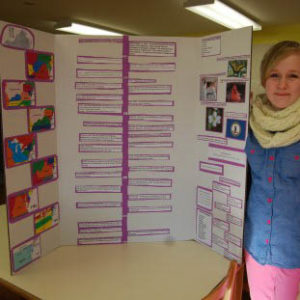 The Adolescent history curriculum is a three-year cycle taught in a Humanities format. The historical component of our humanities curriculum focuses on a study of American History, Civics, and Government during two years and world history in the third-year rotation. Classes include primary and secondary source reading, seminar discussions, research, formal writing assignments, off-site visits, and guest speakers. The Socratic seminar is used to develop critical thinking skills in the analysis of thoughts, ideas and philosophies. Current events are discussed routinely and students constantly tackle topics regarding ethics and justice. Local resources and pedagogy of place provide opportunity to understand larger complex issues within a local study.
The Adolescent history curriculum is a three-year cycle taught in a Humanities format. The historical component of our humanities curriculum focuses on a study of American History, Civics, and Government during two years and world history in the third-year rotation. Classes include primary and secondary source reading, seminar discussions, research, formal writing assignments, off-site visits, and guest speakers. The Socratic seminar is used to develop critical thinking skills in the analysis of thoughts, ideas and philosophies. Current events are discussed routinely and students constantly tackle topics regarding ethics and justice. Local resources and pedagogy of place provide opportunity to understand larger complex issues within a local study.
Spanish
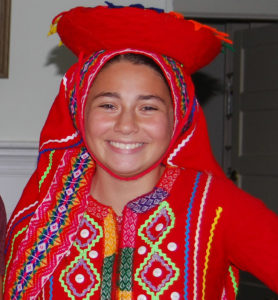 Students are introduced to basic conversational Spanish as they enter the Adolescent program. Our native Spanish speaking instructor teaches Spanish two times a week. Spanish includes studies organized around listening comprehension, reading comprehension, speaking, writing, and cultural aspects of Hispanic countries. After three years, it is our goal for students to have completed the Spanish I course level and be fully prepared to enter Spanish II as 10th graders.
Students are introduced to basic conversational Spanish as they enter the Adolescent program. Our native Spanish speaking instructor teaches Spanish two times a week. Spanish includes studies organized around listening comprehension, reading comprehension, speaking, writing, and cultural aspects of Hispanic countries. After three years, it is our goal for students to have completed the Spanish I course level and be fully prepared to enter Spanish II as 10th graders.
Creative Expression
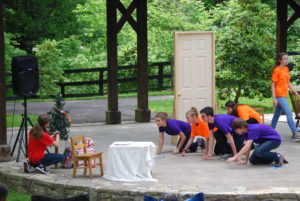 Creative expression is essential to Adolescent development as students explore and experiment with their emerging identities. At this age, the developing personality has a natural predisposition to creative expression in many forms. As such, Mountainside offers as many formal outlets as possible to the students. Students share their talents at “Coffeehouse Performances” with peers, parents and other members of the school community. Students also produce a theatrical performance during the school year. The Adolescent art program supports the students in their exploration of artistic expression. Using a variety of media, students explore design, drawing, painting and sculpture. The focus on art appreciation with art history is interwoven into the academic curriculum. 9th grade students earn an Art 1 credit having covered topics over their three-year cycle in the Adolescent Program.
Creative expression is essential to Adolescent development as students explore and experiment with their emerging identities. At this age, the developing personality has a natural predisposition to creative expression in many forms. As such, Mountainside offers as many formal outlets as possible to the students. Students share their talents at “Coffeehouse Performances” with peers, parents and other members of the school community. Students also produce a theatrical performance during the school year. The Adolescent art program supports the students in their exploration of artistic expression. Using a variety of media, students explore design, drawing, painting and sculpture. The focus on art appreciation with art history is interwoven into the academic curriculum. 9th grade students earn an Art 1 credit having covered topics over their three-year cycle in the Adolescent Program.
Internships
 A week-long career related internship is an important element of the Adolescent curriculum, as it is a way to explore the ideas of learning and leading, as well as the adult world of profession and work. It is a highly anticipated learning experience each year. The internship program offers an extremely valuable opportunity for our students to deepen their understanding of themselves, of others, and of what it takes to participate in the workforce. This opportunity allows the young Adolescent to see how involved and complex an adult’s job can be. The location is selected by the students based upon their personal interests. Over the course of the three-year cycle of the Adolescent Program, students have the opportunity to have three distinct internship experiences.
A week-long career related internship is an important element of the Adolescent curriculum, as it is a way to explore the ideas of learning and leading, as well as the adult world of profession and work. It is a highly anticipated learning experience each year. The internship program offers an extremely valuable opportunity for our students to deepen their understanding of themselves, of others, and of what it takes to participate in the workforce. This opportunity allows the young Adolescent to see how involved and complex an adult’s job can be. The location is selected by the students based upon their personal interests. Over the course of the three-year cycle of the Adolescent Program, students have the opportunity to have three distinct internship experiences.
Community Partnerships
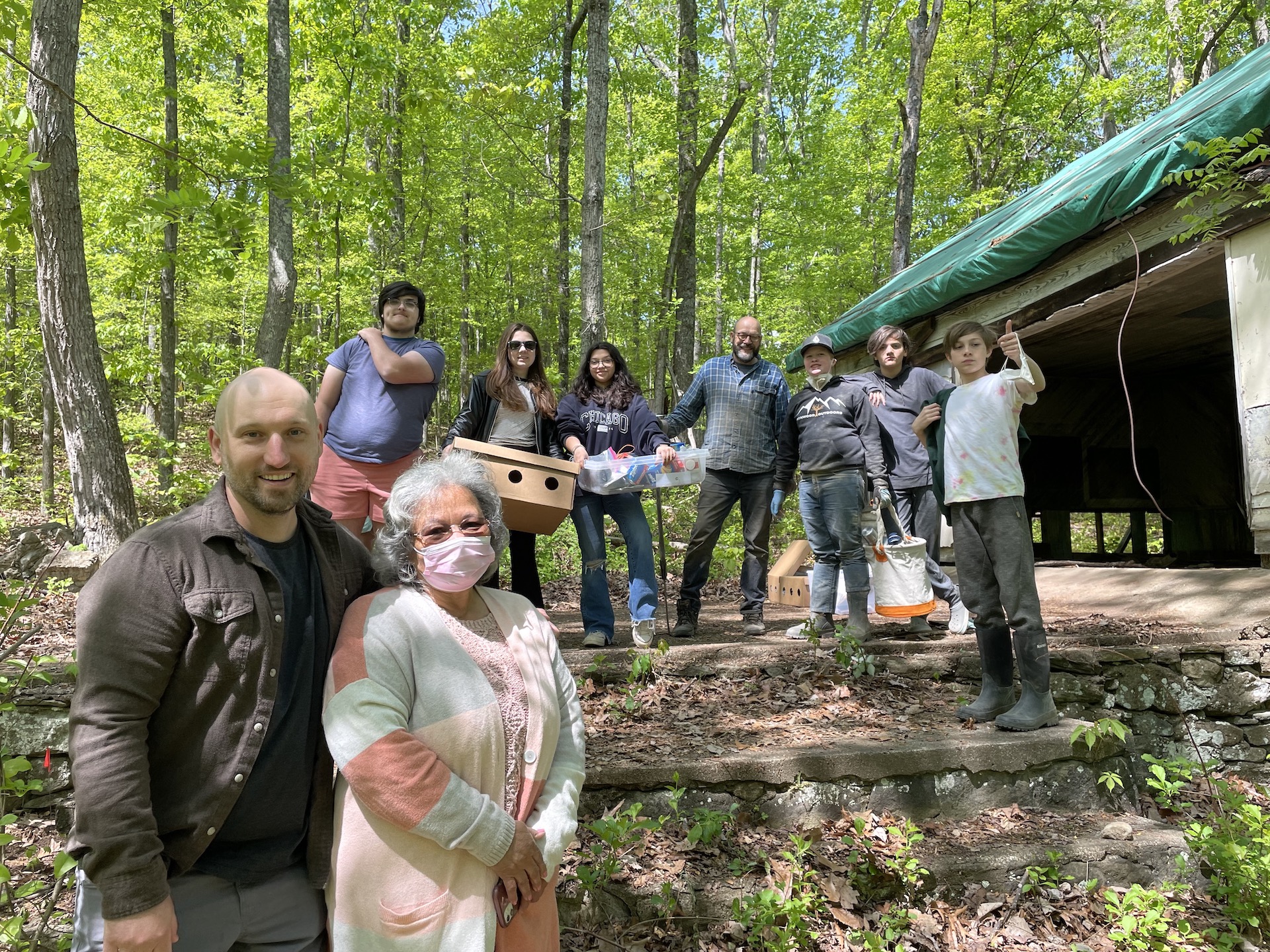 Being involved and contributing to the larger world is an important aspect of Adolescent development. At Mountainside, we partner with local organizations and organize opportunities to engage in real and meaningful work. Community service through Adopt-A-Road clean-up, working at local food banks, raising a hog to support their efforts, and contributing to efforts of local historic and preservation organizations are woven into our academics and program. Recently, the Adolescents partnered with the Afro-American Historical Association of Fauquier County on the restoration and preservation of history of a local African American Morgantown School House Project. Their work is an example of our involvement and value of local service.
Being involved and contributing to the larger world is an important aspect of Adolescent development. At Mountainside, we partner with local organizations and organize opportunities to engage in real and meaningful work. Community service through Adopt-A-Road clean-up, working at local food banks, raising a hog to support their efforts, and contributing to efforts of local historic and preservation organizations are woven into our academics and program. Recently, the Adolescents partnered with the Afro-American Historical Association of Fauquier County on the restoration and preservation of history of a local African American Morgantown School House Project. Their work is an example of our involvement and value of local service.
Trips
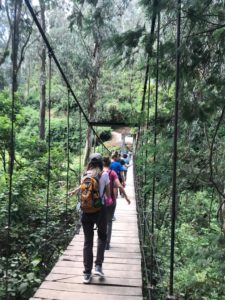 The school year begins and ends with an Odyssey trip, which is a key component of the Montessori Adolescent program’s academic and social experience. The goal is to provide a rich educational experience for the students with a focus on learning and bonding. During the winter term, our 9th grade students plan their own international trip. Students are responsible for all aspects of planning, organizing, and navigating these trips and use the funds from money they have raised in their micro-economy to budget their trips. The trip component of the program is another example of the level at which students are involved in and responsible for their own education with support and guidance from the adults around them. The 9th grade international trips involve an element of community service and are designed to expose students to an understanding of how much of the world lives. In recent years, students have traveled to South Africa, Ecuador, Costa Rica, and Peru.
The school year begins and ends with an Odyssey trip, which is a key component of the Montessori Adolescent program’s academic and social experience. The goal is to provide a rich educational experience for the students with a focus on learning and bonding. During the winter term, our 9th grade students plan their own international trip. Students are responsible for all aspects of planning, organizing, and navigating these trips and use the funds from money they have raised in their micro-economy to budget their trips. The trip component of the program is another example of the level at which students are involved in and responsible for their own education with support and guidance from the adults around them. The 9th grade international trips involve an element of community service and are designed to expose students to an understanding of how much of the world lives. In recent years, students have traveled to South Africa, Ecuador, Costa Rica, and Peru.
